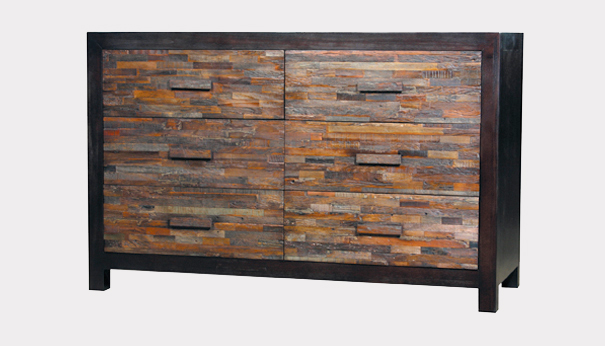Furniture of a Different Stripe
A little known fact about the aesthetic landscape way up here at 9,000+ feet and just west of the Continental Divide: the most desirable architecture features the use of re-claimed wood. Yes, long before the dawn of re-purposing, builders in Crested Butte, Colorado had been reserving their little slice of the wood remnants of 19th. Century barns (from Wisconsin, of all places!), ripping and chopping and staining said planks down to size, then outfitting mountain cabins with magnificent facades in vertically-sided barn wood.
Novo 4 Door Console Table. Manufactured by Environment Furniture.
I mention this appealing trend because of the striking similarities in appearance between these impressive homes and Environment Furniture‘s line of armoires, beds, benches, buffets, and tables—each constructed of “reclaimed, recycled, and sustainably harvested wood.” In contrast to the materials of my mountain compatriots, however, L.A.-based Environment re-claims their wood not from the American Midwest, but the humble hamlets in the environs of Paraná, Brazil. Yes folks, Environment uses primarily re-purposed exotic hardwood: “We obtain our supplies of Peroba by reclaiming it from derelict houses and barns and abandoned buildings… In doing so, we give a second life to this dense, richly colored and textured wood. As the reclaimed wood is, on average, 70 to 100 years old, our designs are enhanced by its unique, weathered characteristics.”

Santomer 3 + 3 Dresser. Manufactured by Environment Furniture.

Santomer Armoir. Manufactured by Environment Furniture.
Thus Environment joins the esteemed ranks of designers and manufacturers who emphasize re-claimed materials — Community, Decades, and A Purple Heart topping my list. But I believe Environment is the only one among them who focuses on the aforementioned Rosa Peroba, in addition to sustainably-harvested Indonesian Mahogany, White Oak, and Poplar. The combination explains the natural beauty of such pieces as the Santomer Armoir, the Novo 4 Door Console Table, and the Santomer 3 + 3 Dresser. Each of these pieces highlights the contrast between the re-claimed, with its wizened silvery patina; and the sustainably-harvested, whose earth-toned palette ranges from amber to chestnut to the richest of chocolates. The result is an elegant fusion of elemental appeal. The pieces remind me of nature: the forested country of the pacific Northwest, its towering trees counterpoised against walls of solid granite; or the rolling hills of Appalachia with its autumnal palate of maples, hickories, and oaks.
Usually such beauty in a furnishing demands a premium price, and not just in dollars and cents. That is to say, somewhere along the continuum from tree to stunning conversation piece, someone (or some eco-system, plant, or animal) suffers. Not so with Environment. The company provides a blueprint of sorts for minimizing this kind of environmental damage: “environmental stewardship is our responsibility and our privilege,” so they say, and they mean it: They’re members of the Tropical Forest Trust (TFT), a U.K.-based organization that assures no certified wood is “obtained through illegal logging, produced through unsustainable forestry practices, or removed from old-growth forests.” Environment also follows a rigorous method “to establish a clean upstream chain of custody”—or to work only with second party suppliers who obtain wood from legitimate sources.
Environment also strives to eliminate pollutants, material waste, and inefficiencies in the manufacturing process: they use non-V.O.C.-emitting stains and glues and non-toxic and low-V.O.C. paints. They also endeavor to minimize production waste whenever possible. And they recognize that true sustainability is a perpetual endeavor: “in the coming years, we will work to further reduce our environmental footprint by re-examining our processes—from the way we source our materials to how we run our offices and stores. Our ultimate objective remains the same; to continue to produce, sell, and distribute furniture of superb design and impeccable environmental credentials.”
via TreeHugger




Leave a Reply